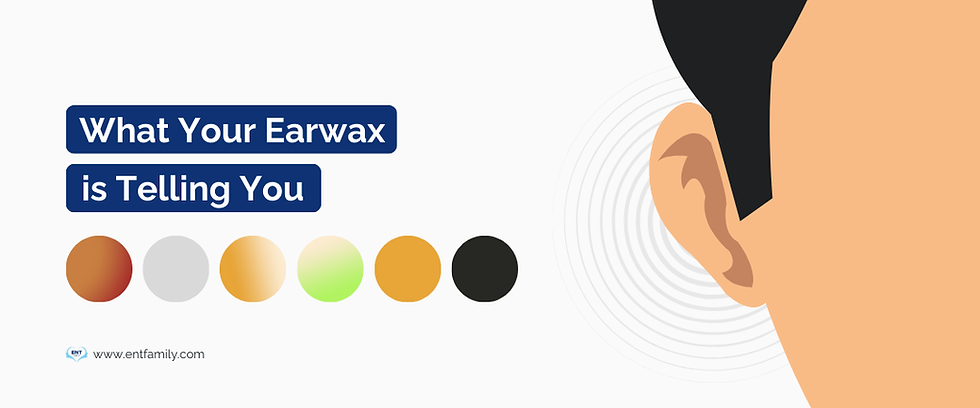What Your Earwax Tells You: Understanding the Colors and Textures
Earwax, also known as cerumen, is something most of us don’t think much about until we need to clean it out. However, the color and texture of your earwax can provide valuable insights into your ear health and overall well-being. In this post, we'll dive into what different earwax characteristics might mean and why you should pay attention to them.

Earwax
Earwax is a substance produced by glands in the outer ear canal to protect the ear. It's a complex mixture primarily composed of sebum (an oily substance), cerumen (a wax-like secretion), dead skin cells, and tiny hairs from the ear canal.
Texture
There are two primary types or textures of earwax:
Wet Earwax: Sticky and yellowish-brown
Dry Earwax: Flaky and light-colored, often gray or tan
The type of earwax you have is dependent on the ABCC11 gene⁽¹⁾. This gene has two versions, or alleles: one that leads to wet earwax and another that results in dry earwax.
The distribution of earwax types varies by population. Around 95-98% of East Asians have dry earwax, while approximately 90% of people of African or European descent have wet earwax⁽¹⁾. This difference isn't just about earwax—it's also linked to variations in sweat composition and body odor.
Color
Dry and Pale Yellow
White to yellow earwax is typical and normal among children, especially if it’s soft or flaky. This color can sometimes indicate a lack of natural oils or a genetic tendency to produce drier earwax.
Amber or Yellow Orange
Amber or honey-colored earwax is generally normal and indicates healthy earwax. Yellow or orange wax is usually fresh and has recently been produced by the glands in your ear canal. This type of earwax is usually sticky and serves its protective function well.
Dark Brown
Dark brown or almost black earwax is usually older earwax that has gathered dust and dirt over time. It’s more common in people who sweat a lot or have naturally darker skin. In most cases, it’s normal.
Yellow Green
This color often suggests an infection, especially if it's accompanied by a foul smell or ear pain.
White, Runny, and Cloudy
This could indicate an infection, especially if accompanied by itching or an unusual odor.
Red-Tinged
The presence of blood in earwax, giving it a red tinge, could indicate an injury or trauma to the ear canal. It might result from scratching, infection, or a ruptured eardrum.
Black
Black earwax is usually due to an accumulation of old earwax that has hardened and darkened over time. This is often seen in cases of cerumen impaction or earwax blockage. However, if it’s accompanied by itching or an odor, it could indicate a fungal infection.
When to See a Doctor
While earwax is a natural and essential part of your ear's defense system, certain changes in color or texture might require medical attention. If you experience any of the following, it’s time to see a healthcare provider:
Persistent pain or discomfort in the ear
Hearing loss or a sensation of fullness in the ear
Foul-smelling earwax or discharge
Dizziness or balance issues
Any sudden change in the color or texture of your earwax
Consult with an Ear Doctor in Hollywood, FL
Ear pain, ringing, or muffled hearing? Our team offers prompt diagnosis and effective treatment. Schedule an appointment today and experience the difference compassionate care can make.
Address: 3911 Hollywood Blvd#201, Hollywood, FL 33021, United States
Phone: 754-888-1368
Email: info@entfamily.com
REFERENCES
[1] Yoshiura, Ki., Kinoshita, A., Ishida, T. et al. A SNP in the ABCC11 gene is the determinant of human earwax type. Nat Genet 38, 324–330 (2006). https://doi.org/10.1038/ng1733
[2] Cleveland Clinic Medical. (n.d.). Earwax: What is it & what does it do?. Cleveland Clinic. https://my.clevelandclinic.org/health/body/24624-earwax
[3] U.S. National Library of Medicine. (n.d.). Ear discharge: Medlineplus medical encyclopedia. MedlinePlus. https://medlineplus.gov/ency/article/003042.htm
[4] Seattle Children’s Hospital. (2022, December 30). Ear - Discharge. https://www.seattlechildrens.org/conditions/a-z/ear-discharge/



.png)
Comments